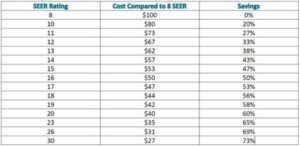How does a SEER rating affect your home’s energy bills?
SEER stands for Seasonal Energy Efficiency Ratio. You can use SEER ratings to measure the amount of energy that is needed to provide a specific amount of cooling to your home. The higher the SEER rating, the more energy-efficient the cooling system is. Standard SEER ratings have increased on cooling equipment over the years as systems become more and more energy-efficient.
Minimum SEER ratings have also increased. Today, a minimum SEER rating of 13 is required for new air conditioning systems, and new heat pumps must meet a minimum rating of 14 SEER.
When you consider that about 40% of your home or small business’s energy costs go into heating and cooling, it’s easy to see how a high-efficiency system can go a long way into cutting down costs.
Our friends at UGI Heating, Cooling & Plumbing have provided the chart below to help illustrate how SEER rating can directly affect your utility bills.

Using the chart above, you can see that a SEER 16 unit, for example, is exactly twice as efficient as a SEER 8 unit, and, therefore, costs 50% less to run. So, if the older SEER 8 unit was costing you $100 a month, the new SEER 16 would cost you only $50.
As mentioned above, SEER ratings have increased significantly over the years. The chart below shows the average SEER rating by year of installation. A system installed in the 1970s probably only has a SEER rating of about 7, whereas one installed in 2005 is probably closer to 13 SEER.
![]()
So, if your cooling bills seem extremely high, it may be time to consider replacing your old central air system or heat pump with a newer, much more efficient model.